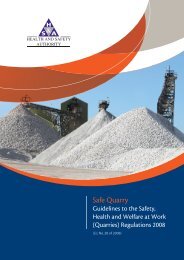The Noise of Music.pdf - Health and Safety Authority
The Noise of Music.pdf - Health and Safety Authority
The Noise of Music.pdf - Health and Safety Authority
You also want an ePaper? Increase the reach of your titles
YUMPU automatically turns print PDFs into web optimized ePapers that Google loves.
<strong>The</strong> <strong>Noise</strong> <strong>of</strong> <strong>Music</strong><br />
Hearing protection zones<br />
If any employee is likely to be exposed to noise at or above<br />
either upper exposure action value, the employer must<br />
ensure that the area is designated a hearing protection zone.<br />
Signs have to be put up to identify the area <strong>and</strong> the use <strong>of</strong><br />
appropriate hearing protection enforced. For example,<br />
stages, front stage pits <strong>and</strong> PA wings (public address wings)<br />
are <strong>of</strong>ten high noise areas at concerts. Access to these high<br />
noise areas should be restricted to essential personnel only<br />
<strong>and</strong> all workers must be adequately protected.<br />
In situations where temporary concert stages are established<br />
(for example at outdoor festivals or concerts in marquees),<br />
the constraints <strong>of</strong> time may not allow a detailed noise<br />
exposure assessment to be carried out. Nevertheless, noise<br />
control measures are still required. In such instances the<br />
organisers should assume that the entire stage area, the pit<br />
area, the front-<strong>of</strong>-house control position <strong>and</strong> any locations<br />
adjacent to speakers are liable to remain high noise areas<br />
even if a range <strong>of</strong> control measures have been enacted. Such<br />
areas should be specified as hearing protection zones <strong>and</strong><br />
clearly signed; workers in hearing protection zones should<br />
be required to adopt suitable personal hearing protection.<br />
Once hearing protection zones have been identified, it is<br />
possible to determine who will have to work in those areas.<br />
Careful planning may mean that some tasks can be<br />
completed when the noise hazard is not present, for<br />
example ensuring that lighting focusing <strong>and</strong> sound checking<br />
are carried out at different times.<br />
Provision <strong>of</strong> information <strong>and</strong> training<br />
If any worker is likely to be exposed to noise at or above 80<br />
dB, the employer must provide suitable <strong>and</strong> sufficient<br />
information <strong>and</strong> training relating to risks resulting from<br />
exposure to noise, including:<br />
• <strong>The</strong> nature <strong>of</strong> the risks.<br />
• Measures to avoid or reduce exposure.<br />
• Results <strong>of</strong> risk assessments <strong>and</strong> noise measurements.<br />
• Correct use <strong>of</strong> individual hearing protectors.<br />
• Entitlement to <strong>and</strong> purpose <strong>of</strong> health surveillance.<br />
• Safe working practices.<br />
People in the music <strong>and</strong> entertainment sectors have to be<br />
made aware <strong>of</strong> the potential for permanent hearing damage<br />
associated with working in a high noise environment. Such<br />
awareness may require a considerable shift in both personal<br />
attitudes <strong>and</strong> collective culture. However, it is a necessary<br />
precursor to achieving long-term protection <strong>of</strong> hearing.<br />
Underst<strong>and</strong>ing the risks from high sound levels should form<br />
part <strong>of</strong> the basic education <strong>of</strong> performers <strong>and</strong> technicians,<br />
which will mean that people coming into the industry are<br />
aware <strong>of</strong> how to protect themselves <strong>and</strong> thus become part<br />
<strong>of</strong> the solution rather than the problem. On a more<br />
immediate level, information <strong>and</strong> instruction should also<br />
include the posting <strong>of</strong> warning notices around designated<br />
high sound level areas <strong>and</strong> the briefing <strong>of</strong> crews regarding<br />
the noise reduction strategies adopted for the event.<br />
Employers should ensure that employees underst<strong>and</strong> the<br />
need to follow their or the venue operator’s instructions on<br />
control measures. For example, employees must abide by<br />
any agreed arrangements for job rotation or restriction <strong>of</strong><br />
access to noisy areas, follow any instructions relating to<br />
achieving agreed noise levels, <strong>and</strong> wear hearing protection<br />
when required.<br />
Promoters should consider the possibility <strong>of</strong> sanctions<br />
against performers who do not abide by the ‘house rules’.<br />
10

















